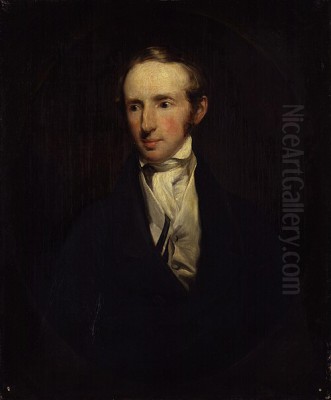
Samuel Prout stands as a significant figure in the history of British art, particularly celebrated for his mastery of the watercolour medium and his evocative depictions of architectural subjects. Born in Plymouth on September 17, 1783, and passing away in Camberwell, London, on February 10, 1852, Prout's life spanned a period of immense change and artistic development in Britain. He rose from provincial beginnings to become one of the most popular and influential watercolourists of his generation, leaving behind a rich legacy of drawings, paintings, and prints that continue to captivate audiences with their charm, detail, and atmospheric quality. His work not only documented the appearance of historic buildings across Britain and continental Europe but also played a crucial role in shaping the popular taste for the Picturesque.
Early Life and Artistic Awakening in Plymouth
Samuel Prout's origins lie in the bustling port town of Plymouth, Devon. He was the fourth child of Samuel Prout Sr., a naval outfitter and bookseller, and Catherine Prout. His childhood was marked by a severe sunstroke incident which resulted in lifelong debilitating headaches and periods of convalescence. These health challenges, however, inadvertently fostered his artistic inclinations, as drawing became a solace and occupation during times he was confined indoors.
His natural talent for drawing was evident early on. He received his education at Plymouth Grammar School, where his artistic abilities likely gained recognition. A formative influence during these early years was the antiquarian and topographer John Britton. Britton, visiting Devon to gather material for his publication Beauties of England and Wales, encountered the young Prout and his contemporary Benjamin Robert Haydon, another Plymouth native destined for artistic fame, sketching outdoors. Impressed by Prout's potential, Britton took him under his wing.
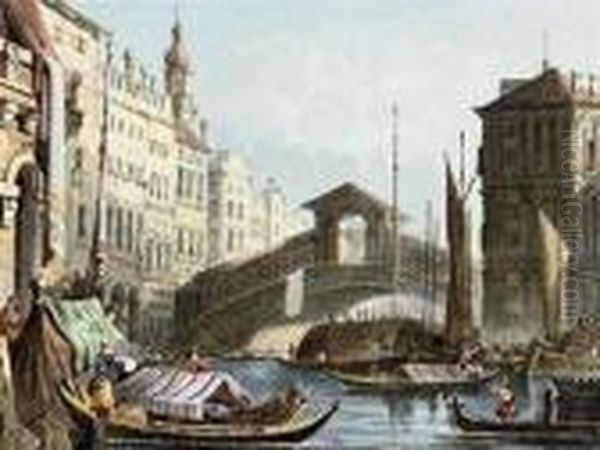
Around 1801-1802, Britton brought Prout to London, lodging him in his Clerkenwell home for nearly two years. This period was intended as an apprenticeship, with Prout tasked with sketching antiquarian subjects in various counties for Britton's publications. While this provided valuable experience and exposure, the arrangement proved challenging for the young artist, who struggled with the demands and perhaps his own diffidence. Despite difficulties, this early association with Britton provided Prout with crucial connections and his first professional commissions, setting the stage for his future career.
Return to Devon and Early Professional Steps
Due to ongoing health problems and perhaps the pressures of London life, Prout returned to Plymouth around 1805. Back in his native Devon, he continued to hone his skills, focusing primarily on marine subjects and coastal scenery – themes readily available in his surroundings. He began exhibiting his work, sending drawings to the Royal Academy exhibition in London as early as 1803.
During this period in the West Country, Prout established himself locally as a drawing master, a common profession for artists seeking stable income. He also continued to produce topographical views, some of which were engraved for publications like Picturesque Views of Devon. His style at this stage was still developing, influenced by the prevailing topographical tradition, but already showing a sensitivity to light and atmosphere that would become hallmarks of his later work. He was absorbing the influences of earlier watercolourists and contemporaries, likely studying the works of artists like Thomas Girtin, whose broad washes and atmospheric effects were revolutionizing the medium.
Establishing a Career in London
Around 1808, Samuel Prout made a decisive move back to London, determined to establish himself in the capital's competitive art world. He initially found employment as a drawing master at a school in Dulwich run by Dr. Glennie, a position previously held by the landscape painter William Havell. Teaching provided financial stability, allowing him to pursue his own artistic practice more freely.
He became increasingly involved with London's artistic societies. In 1810, he exhibited with the Associated Artists in Water-Colours (also known as the Associated Painters in Water-Colours), a group formed in opposition to the older Society of Painters in Water-Colours (often called the Old Watercolour Society or OWS). When the Associated Artists folded, Prout sought election to the more established OWS. He was elected an associate exhibitor in 1815 and became a full member in 1819 (or 1820, sources vary slightly), an affiliation he maintained for the rest of his life.
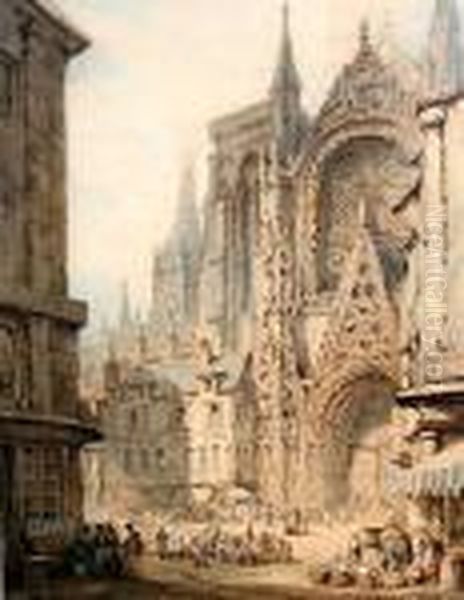
Membership in the OWS was crucial. It provided a prestigious platform for exhibiting and selling his work annually, alongside prominent contemporaries like David Cox, Copley Fielding, Peter De Wint, and William Henry Hunt. During these years, Prout's subject matter gradually shifted. While still painting coastal scenes and rustic landscapes, he began to develop a stronger interest in architectural subjects, finding inspiration in the dilapidated cottages, ancient churches, and picturesque ruins of Britain.
The Pivotal Journey Abroad and the Architectural Focus
A turning point in Prout's career came in 1819. Suffering from persistent ill health, he was advised to travel abroad for a change of air. He journeyed to the continent for the first time, visiting Le Havre and Rouen in Normandy, France. This trip was a revelation. He was immediately captivated by the unfamiliar and often decaying grandeur of continental architecture – the ornate facades, towering cathedrals, bustling market squares, and picturesque street scenes.
This first continental tour fundamentally redirected his artistic focus. He discovered his true métier: the depiction of historic European architecture. The textures of weathered stone, the intricate carvings, the play of light and shadow on complex structures, and the vibrant street life surrounding these buildings offered a wealth of subjects perfectly suited to his developing style. He found that these scenes resonated deeply with the burgeoning Romantic sensibility and the British taste for the Picturesque.
From 1819 onwards, Prout made regular trips across the English Channel. Over the next two decades, he became an inveterate traveller, sketching extensively in France (Normandy, Brittany, Paris), Belgium, the Netherlands, Germany (especially along the Rhine), Switzerland, and Italy (most notably Venice). These journeys provided the raw material for the watercolours and, later, lithographs that would cement his fame.
Prout's Distinctive Watercolour Style
Samuel Prout developed a highly individual and instantly recognizable watercolour style, particularly suited to his architectural subjects. His technique evolved from the broader washes of his earlier work to a more detailed and texturally rich approach. A key characteristic was his use of broken, angular lines, often reinforced with pen and ink, typically using a fine reed pen which produced a distinctive, slightly hesitant but expressive mark. This technique was particularly effective in rendering the crumbling textures of old stone, weathered timber, and intricate Gothic tracery.
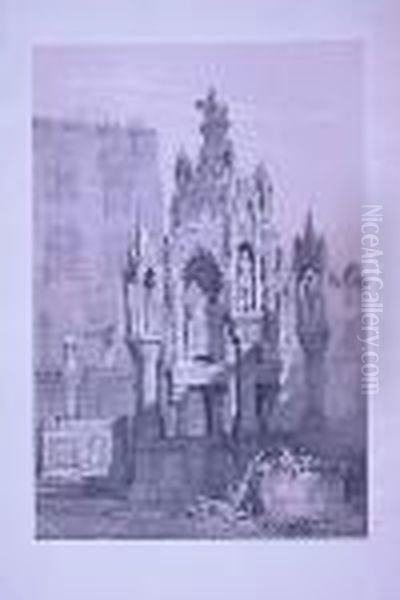
He often began with a detailed pencil drawing, over which he applied washes of colour. His palette was generally warm, favouring ochres, browns, and muted reds and blues, which enhanced the sense of age and history in his subjects. He masterfully controlled light and shadow to create dramatic effects and define architectural forms. Unlike the pure transparent washes favoured by some contemporaries, Prout frequently incorporated bodycolour (opaque watercolour, or gouache), especially white highlights, to accentuate details, suggest textures, and add sparkle to his compositions.
Another defining feature of Prout's work is the inclusion of lively figures in local costume. These figures were not mere accessories; they served to animate the scenes, provide a sense of scale, and enhance the picturesque quality. Market stalls, busy town squares, and boats navigating canals are populated with deftly sketched characters that add narrative interest and local colour. His compositions often employed framing devices, viewing scenes through archways or down narrow, shadowed streets, enhancing the sense of discovery and picturesque charm.
Pioneer of Artistic Lithography
Beyond his watercolours, Samuel Prout made significant contributions as one of the earliest and most accomplished British artists to embrace the medium of lithography. Invented in Germany in the late 1790s, lithography allowed artists to draw directly onto a stone plate, offering greater freedom and autographic quality compared to engraving or etching. Prout quickly recognized its potential for reproducing the character of his pencil and chalk sketches.
Starting in the 1810s, Prout began producing lithographs, often working with leading printers like Charles Hullmandel. He published numerous sets of lithographic prints based on his travel sketches. These publications were immensely popular and highly influential, making his picturesque views of continental Europe accessible to a wide audience. They catered to the growing interest in travel and foreign scenery, particularly in the post-Napoleonic era when continental travel became feasible again for the British.
Among his most celebrated lithographic series are Rudiments of Landscape in Progressive Studies (1813), aimed at students, Sketches in France, Switzerland and Italy (1839), Sketches in Flanders and Germany (1833), and Sketches at Home and Abroad (1844). These volumes, often featuring tinted lithographs that approximated the effect of watercolour washes, showcased his distinctive drawing style – the broken lines, rich textures, and dramatic compositions – translated effectively into print. Prout's lithographs were admired for their artistic quality and played a crucial role in disseminating the Picturesque aesthetic.
Representative Works and Common Themes
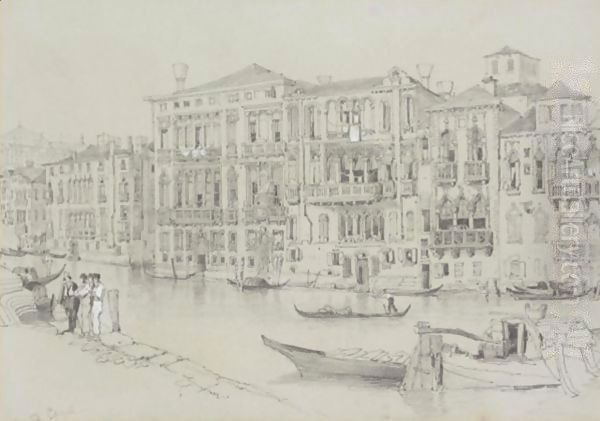
Prout's vast output makes selecting just a few representative works challenging, but certain subjects and locations appear frequently and exemplify his style. His depictions of Venice are particularly renowned. Works like The Rialto Bridge, Venice or The Bridge of Sighs capture the unique atmosphere of the city, blending architectural grandeur with the reflections and activity of the canals. He rendered the decaying stonework and ornate details with characteristic sensitivity.
His views of Northern French towns like Rouen, Caen, and Lisieux are also iconic. He excelled at depicting the half-timbered houses, towering cathedral facades (like Rouen Cathedral), and bustling market squares of Normandy. These works often emphasize the verticality and intricate detail of Gothic architecture, contrasted with the lively human element below.
German subjects, particularly cities along the Rhine like Cologne and Nuremberg, and towns such as Regensburg (e.g., The Door of the Cathedral of St. Peter in Regensburg), provided ample material. He captured the distinctive character of German medieval and Renaissance architecture, often focusing on ornate doorways, elaborate gables, and picturesque street perspectives. His lithographic series dedicated to Flanders and Germany further popularized these views.
While best known for continental scenes, Prout continued to paint British subjects throughout his career, including coastal views, rustic cottages, and ancient ruins. These earlier works, while perhaps less dramatic than his continental views, demonstrate his foundational skills in landscape and his enduring connection to his native country. His published drawing manuals often used examples drawn from both British and European scenery.
Artistic Relationships, Influence, and Recognition
Samuel Prout occupied a prominent position within the British art world, interacting with numerous artists, critics, and patrons. His long association with the Old Watercolour Society placed him at the heart of the watercolour movement, alongside figures like David Cox, Copley Fielding, and Peter De Wint. While friendly, there was also an element of professional competition among these artists, each developing their own niche within landscape and architectural painting.
His early connection with Benjamin Robert Haydon, though their artistic paths diverged significantly, remained. Haydon, known for his ambitious history paintings, reportedly encouraged Prout's focus on architecture. A more significant relationship was with the influential critic and artist John Ruskin. Ruskin deeply admired Prout's work from childhood, seeing in it an honesty, sensitivity, and appreciation for the textures of time-worn architecture that resonated with his own aesthetic and moral philosophy.
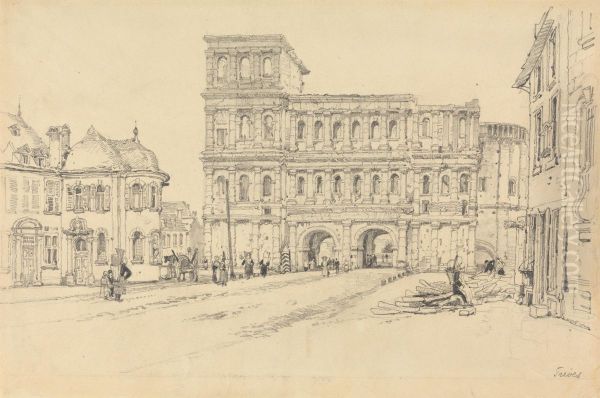
Ruskin praised Prout extensively in his writings, particularly in Modern Painters and The Stones of Venice. He lauded Prout's ability to capture the "parasitical sublimity" of continental architecture – the beauty found in age, decay, and intricate detail. Ruskin even took lessons from Prout and imitated his drawing style. The famous quote attributed to Ruskin, "Sometimes I tire of Turner, but never of Prout," highlights his enduring affection for Prout's less overwhelming but consistently charming art. This powerful advocacy significantly boosted Prout's reputation and influence.
Prout also influenced younger artists through his teaching and widely circulated publications. His nephew, John Skinner Prout (1805-1876), followed closely in his uncle's footsteps, becoming a watercolourist and lithographer known for his views of Britain and, notably, Australia, where he spent several years. Prout's drawing manuals provided instruction for countless amateur and professional artists, propagating his methods for rendering landscape and architecture. His connection with publishers like Rudolph Ackermann was also vital, facilitating the dissemination of his work through prints and illustrated books. He provided drawings for Ackermann's popular Repository of Arts among other publications.
Prout achieved considerable recognition during his lifetime. In 1829, he was appointed Painter in Water-Colours in Ordinary to King George IV, an honour renewed under William IV and Queen Victoria. This royal patronage underscored his status as a leading artist in the medium. His works were eagerly collected by the public and fellow artists alike.
Later Life and Enduring Legacy
Despite his chronic health issues, Samuel Prout remained remarkably productive throughout his life. He continued to travel, sketch, and exhibit regularly at the Old Watercolour Society until shortly before his death. His later works maintained the characteristics of his mature style, though some critics noted a tendency towards formula in his compositions over time. Nevertheless, his popularity remained high.
He spent his final years living in Camberwell, then a suburb of London. Samuel Prout died there on February 10, 1852, after suffering a stroke. He was buried in West Norwood Cemetery.
Samuel Prout's legacy is multifaceted. He was a pivotal figure in the golden age of British watercolour painting, developing a unique and highly influential style for depicting architectural subjects. His work perfectly captured the spirit of the Picturesque, celebrating the beauty of age, texture, and irregularity in both the built and natural environments. His numerous watercolours and lithographs not only documented countless historic sites across Europe but also shaped how generations perceived these places.
His influence extended through his teaching, his popular publications, and the high regard in which he was held by critics like Ruskin. He demonstrated the potential of watercolour for capturing complex architectural detail and atmospheric effects, and he was a pioneer in the artistic use of lithography in Britain. Today, his works are held in major museum collections worldwide, including the Victoria and Albert Museum, the British Museum, Tate Britain, and numerous regional galleries in the UK, as well as institutions in North America and Australia. Samuel Prout remains celebrated as a master of architectural watercolour, whose charming and evocative views continue to delight viewers and offer valuable insights into the art and travel culture of the 19th century. His contribution lies not just in technical skill, but in his ability to imbue stone and timber with a sense of history, romance, and enduring picturesque appeal.